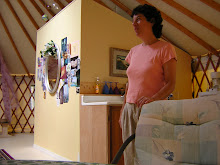You are invited to the Summer Solstice Potluck and Labyrinth Walk on Sunday June 20th from 6:00pm to 10:00Pm. Enjoy good fellowship and food, and learn about the labyrinth's unique history. Walk it in daylight, at sundown or in the glow of candlelight. it's mystery and healing are always present. Bring a dish to share, and the beverage of your choice. A Vegetarian lasagna ,salad and bread will be provided.
A $5.00 dollar offering would be appreciated
Wednesday, June 9, 2010
Thursday, June 3, 2010
The Japanese Zen Garden at the Yurtgarden
The Japanese Zen garden sits in the shade of a hedge of wild hydrangeas,directly in front of the Yurt. You can stand on the deck and view it, or go down the steps and rake the white sand into ripples, letting your mind go!
The first Zen Gardens appeared between 1392 and 1568AD. These gardens are still found on the grounds of monasteries across Japan today. The gardens represent a living work of art changing during each season. The composition always relies on some framework. At the Yurt, a small concrete pagoda fills that niche. Stones and large rocks become mountains and hills. The most important element missing is water!
Yet the representation and feeling of water is experienced in the raking of the sand. Zen priests practice the art of raking to help their concentration. They try to get their lines of sand as perfect as they can, using this act as a form of meditation. These mini landscapes become mindscapes to focus on the inner calm. Pruned treees and shrubs add to the sense of inner order inside the changing vegetation of each season.
A workshop will soon be offered at the Yurtgarden to learn how to create your own Zen garden. Stay tuned... Peace, Lynn
The first Zen Gardens appeared between 1392 and 1568AD. These gardens are still found on the grounds of monasteries across Japan today. The gardens represent a living work of art changing during each season. The composition always relies on some framework. At the Yurt, a small concrete pagoda fills that niche. Stones and large rocks become mountains and hills. The most important element missing is water!
Yet the representation and feeling of water is experienced in the raking of the sand. Zen priests practice the art of raking to help their concentration. They try to get their lines of sand as perfect as they can, using this act as a form of meditation. These mini landscapes become mindscapes to focus on the inner calm. Pruned treees and shrubs add to the sense of inner order inside the changing vegetation of each season.
A workshop will soon be offered at the Yurtgarden to learn how to create your own Zen garden. Stay tuned... Peace, Lynn
Subscribe to:
Posts (Atom)
